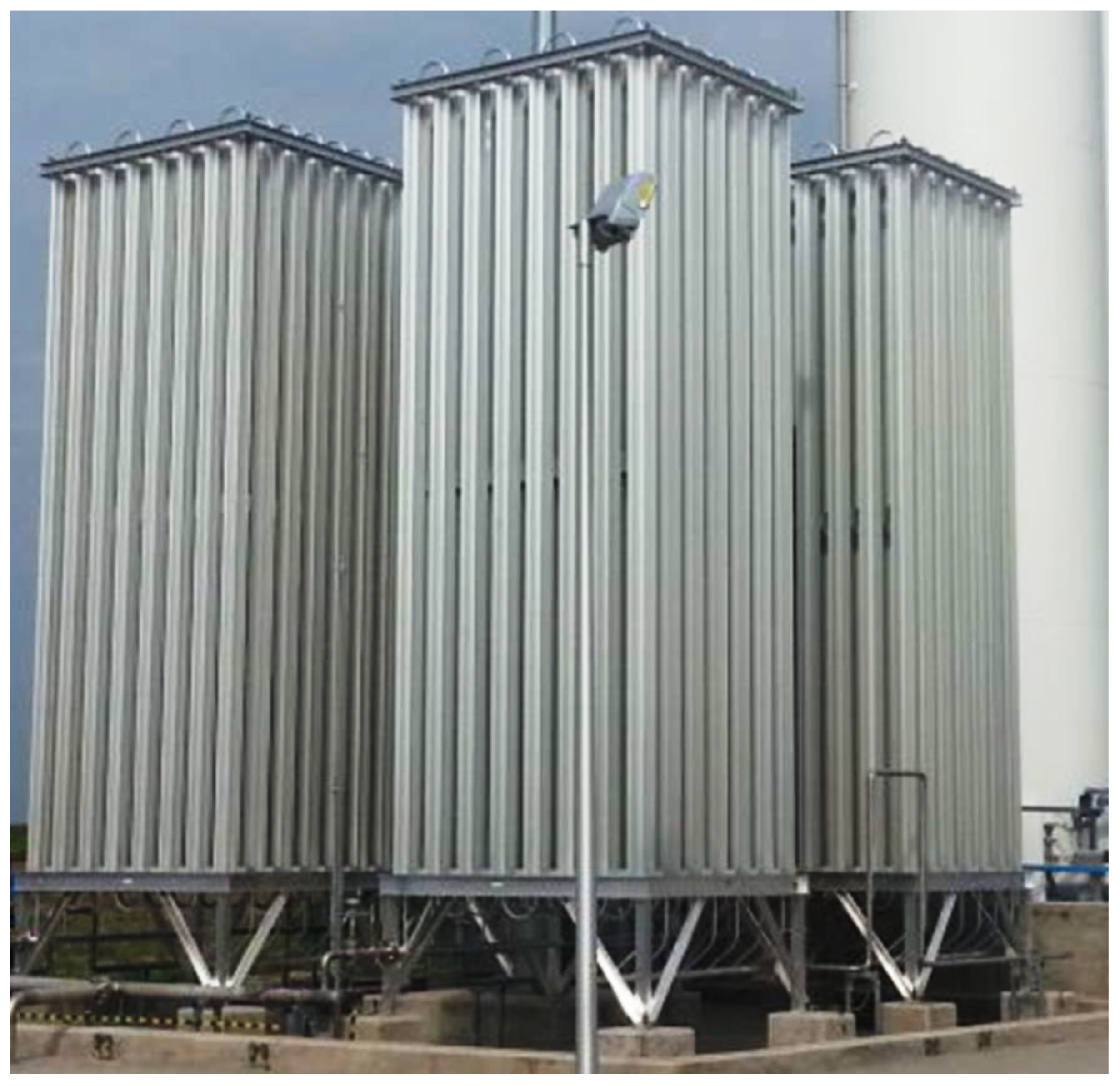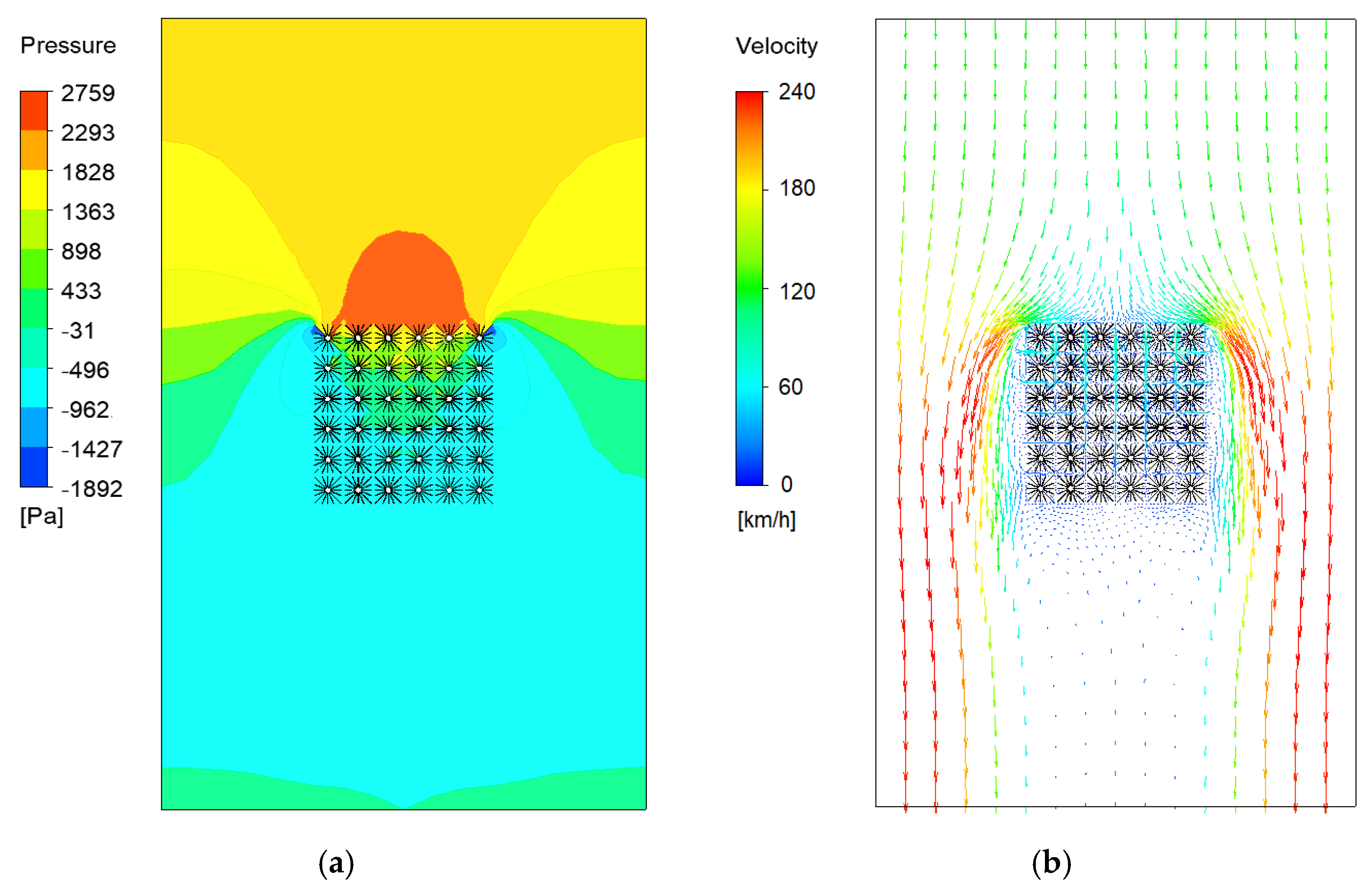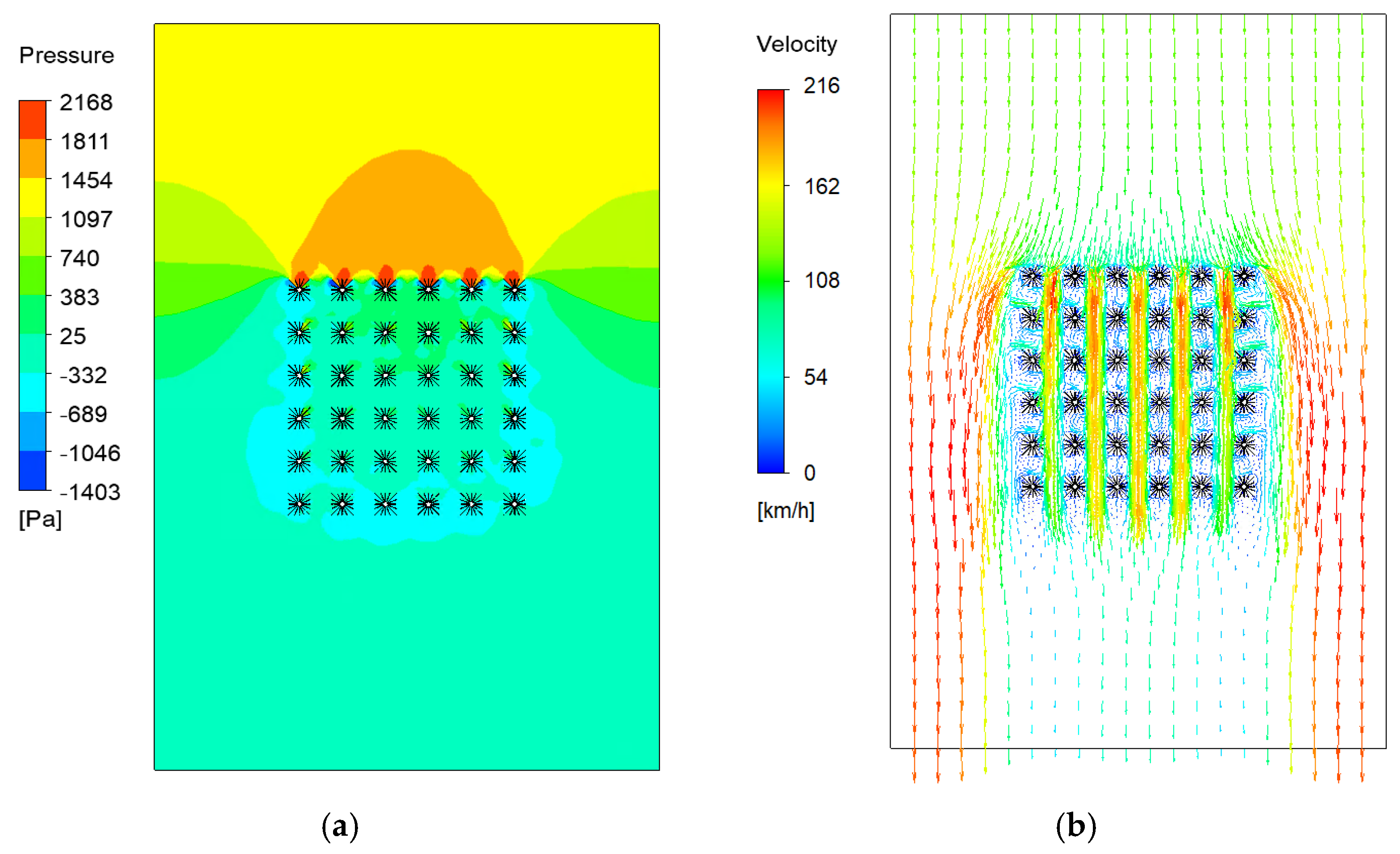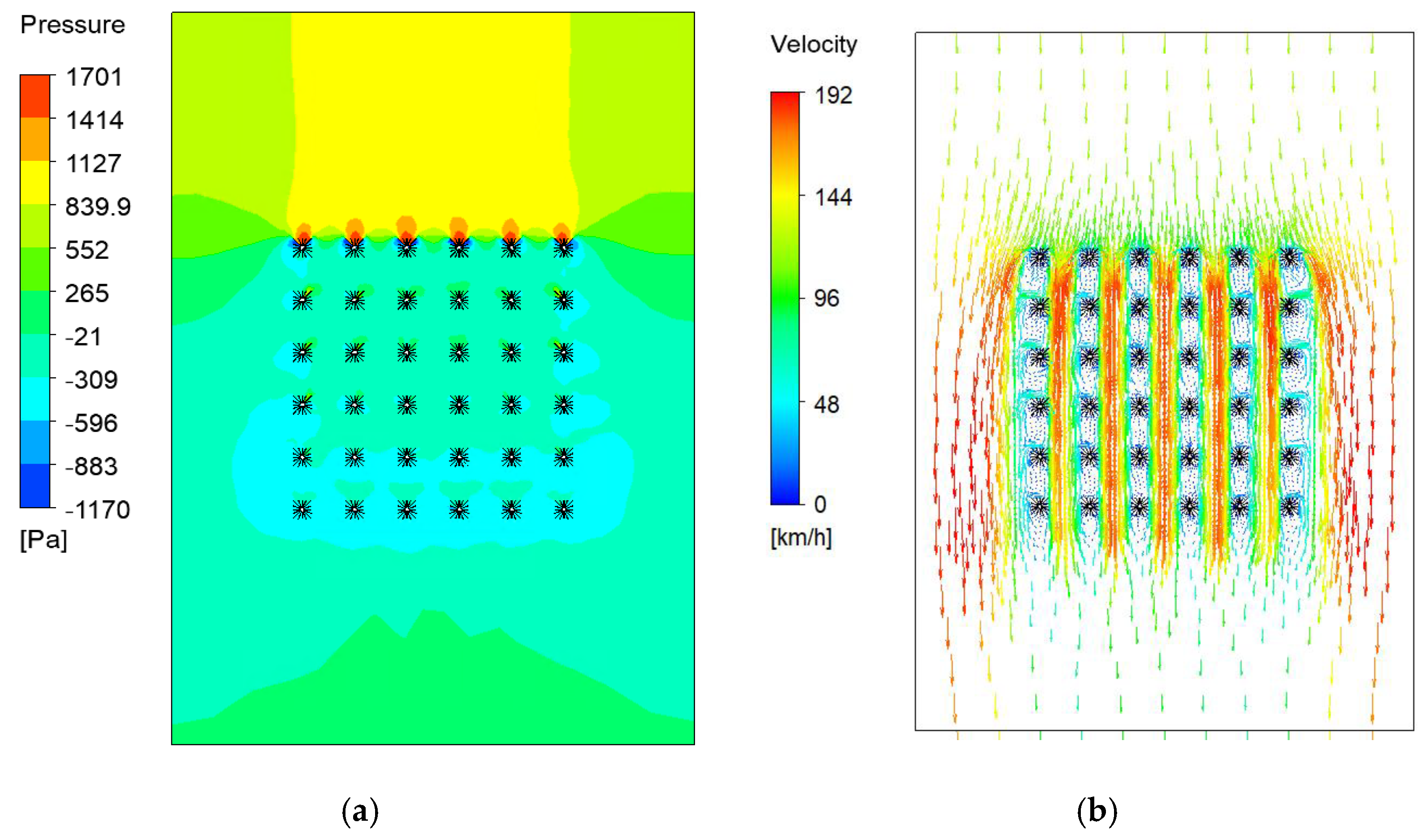Influence of Longitudinal Fin Tubes Arrangement in LNG Ambient Air Vaporizers on the Wind Load
Abstract
:1. Introduction
1.1. Ambient Air Vaporizers Design Issues
1.2. The Object of Study
2. CFD Analysis of Air Flow
2.1. Discrete Model and Analysis Assumptions
- Considering that the wind velocity component in front of the vaporizer has only one flow direction and two flow directions within the vaporizer structure, the use of the 2D model was sufficient for the considered problem. The models were prepared for analyses including wind directions α of 90° and 45°. Discrete models with boundary condition for the example of the vaporizer with tubes distribution pitch of 350 mm and wind directions of 90° and 45° are shown in Figure 3, where vinlet is the wind velocity and patm stands for atmospheric pressure. Dimensions in Figure 3 are in mm. The mesh independence test was performed at the preliminary study. The results of mesh independence test for the example of the vaporizer with tubes distribution pitch of 350 mm, wind directions of 90° and wind speed of 120 km/h are shown in Figure 4.
- All longitudinal finned tubes in the vaporizer were of the same cross-section.
- There were no other objects in front of and behind the vaporizer.
- There were no other objects on the sides of vaporizer at least at a distance of 1 m.
- The air velocity was constant at a distance of 2 m in front of the vaporizer.
- Air density ρ = 1.225 kg/m3.
- Air viscosity μ = 1.7894 × 105 kg/ms.
2.2. Results and Discussion
3. Conclusions
- In view of the possibility of achieving large overall dimensions and the large surface area on which the wind can pressurize, considerable mechanical loads occur in the construction of ambient air vaporizers. For constant wind speed, the value of average wind load on the vaporizer structure and the maximum load acting locally on individual tubes depends on their arrangement in the array and wind direction.
- In this study, the average load per 1 m length of finned tubes was determined by applying CFD analysis. The obtained results should be considered in terms of several design aspects. The first of these is the average wind load acting on the whole structure of the vaporizer. This load must be considered in the mechanical design of the supporting structure and for its anchorage to the ground. Another aspect concerns the maximum load on individual tubes, which should be designed concerning the maximum load that can occur on any single one.
- It was revealed that for a wind direction of 90°, the pitch of finned tube arrangement slightly affects the average load of the vaporizer. On the other hand, for a wind direction of 45°, the effect of varying the pitch of finned tubes arrangement on the average load is significant due to the change in effective wind area.
- From a mechanical strength point of view, it is advantageous that the variation in wind load on all tubes is as low as possible. Increasing the distance between the finned tubes increases the overall dimensions of the vaporizer, but the maximum pressure can be reduced by up to 50%. However, the average wind load on the structure simultaneously increases. Particularly for a wind direction of 45°, this load can increase by several times with increasing pitch of the finned tubes arrangement.
- Considering the above aspects, it can be concluded that the distribution of longitudinal finned tubes in the vaporizer structure should be determined by an optimization process, which can be considered as a direction for further research.
Author Contributions
Funding
Institutional Review Board Statement
Informed Consent Statement
Data Availability Statement
Conflicts of Interest
References
- BP Statistical Review of World Energy, 2019, 68th Edition. Available online: https://www.bp.com/content/dam/bp/business-sites/en/global/corporate/pdfs/energy-economics/statistical-review/bp-stats-review-2019-full-report.pdf (accessed on 20 April 2021).
- Cainenga, Z.; Qunb, Z.; Guoshengb, Z.; Bob, X. Energy revolution: From a fossil energy era to a new energy era. Nat. Gas Ind. 2016, B3, 1–11. [Google Scholar] [CrossRef] [Green Version]
- Ma, X. Natural gas and energy revolution: A case study of Sichuane Chongqing gas province. Nat. Gas Ind. 2017, B4, 91–99. [Google Scholar] [CrossRef] [Green Version]
- Leung, G.C.K. Natural Gas as a Clean Fuel. In Handbook of Clean Energy Systems; John Wiley & Sons: Hoboken, NJ, USA, 2015. [Google Scholar] [CrossRef]
- Grønhaug, R.; Christiansen, M. Supply Chain Optimization for the Liquefied Natural Gas Business. In Innovations in Distribution Logistics. Lecture Notes in Economics and Mathematical Systems; Nunen, J., Speranza, M., Bertazzi, L., Eds.; Springer: Berlin/Heidelberg, Germany, 2019; Volume 619. [Google Scholar] [CrossRef]
- Lisowski, E.; Lisowski, F. Study on thermal insulation of liquefied natural gas cryogenic road tanker. Therm. Sci. 2019, 23 (Suppl. 4), S1381–S1391. [Google Scholar] [CrossRef] [Green Version]
- Lisowski, F.; Lisowski, E. Design of internal supports for double-walled liquefied natural gas road tanker. Heat Transf. Eng. 2021, 8, 1–10. [Google Scholar] [CrossRef]
- Agarwal, R.; Rainey, T.J.; Rahman, S.M.A.; Steinberg, T.; Perrons, R.K.; Brown, R.J. LNG Regasification Terminals: The Role of Geography and Meteorology on Technology Choices. Energies 2017, 10, 2152. [Google Scholar] [CrossRef] [Green Version]
- Tiana, X.; Jiaoa, W.; Rena, L.; Liub, S.; Liua, T. Research on climate zoning indicators for operating environment of liquefied natural gas ambient air vaporizer. Sustain. Cities Soc. 2020, 60, 102186. [Google Scholar] [CrossRef]
- Jeong, H.M.; Chung, H.S.; Djajadiwinata, E.; Kim, P.H.; Lee, Y.H. Experimental study on the characteristics of longitudinal fin air-heating vaporizers in different seasons. J. Mech. Sci. Technol. 2008, 22, 981–990. [Google Scholar] [CrossRef]
- Cryogenic Industries. The Advantages of Using Ambient Air Vaporizers throughout the Entire LNG Market. Frostbyte, a Newsletter from Cryogenic Industries, Winter 2015. Available online: https://cryoind.com/wp-content/uploads/2015/03/2015_Winter_FrostByte_low_res_FINAL1.pdf (accessed on 10 June 2020).
- Jeong, H.M.; Lee, Y.H.; Ji, M.K.; Bae, K.Y.; Chung, H.S. Natural convection heat transfer estimation from a longitudinally finned vertical pipe using CFD. J. Mech. Sci. Technol. 2009, 23, 1517–1527. [Google Scholar] [CrossRef]
- Kopeć, P.; Niezgoda-Żelazko, B. Heat transfer on the outer Surface of vertical longitudinally finned tubes. IOP Conf. Ser. Earth Environ. Sci. 2019, 214, 012058. [Google Scholar] [CrossRef]
- Sun, B.; Wadnerkar, D.; Utikar, R.P.; Tade, M.; Kavanagh, N.; Faka, S.; Evans, G.M.; Pareek, V.K. Modeling of Cryogenic Liquefied Natural Gas Ambient Air Vaporizers. Ind. Eng. Chem. Res. 2018, 57, 9281–9291. [Google Scholar] [CrossRef]
- Lee, Y.; Na, J.; Lee, W.B. Robust design of ambient-air vaporizer based on time-series clustering. Comput. Chem. Eng. 2018, 118, 236–247. [Google Scholar] [CrossRef]
- Lee, K.-S.; Kim, W.-S.; Lee, T.-H. A one-dimensional model for frost formation on a cold flat surface. Int. J. Heat Mass Transf. 1997, 40, 4359–4365. [Google Scholar] [CrossRef]
- Jeong, H.-M.; Chung, H.-S.; Lee, S.-C.; Kong, T.-W.; Yi, C.-S. Optimum design of vaporizer fin with Liquefied Natural Gas by numerical analysis. J. Mech. Sci. Technol. 2006, 20, 545–553. [Google Scholar] [CrossRef]
- Chen, S.; Yao, S.; Xie, F. Analysis of Thermal Conductivity of Frost on Cryogenic Finned-tube Vaporizer Using Fractal Method. Energy Power Eng. 2013, 5, 109–115. [Google Scholar] [CrossRef]
- Kuang, Y.; Yi, C.; Wang, W. Numerical simulation of frosting behavior and its effect on a direct-contact ambient air vaporizer. J. Nat. Gas Sci. Eng. 2015, 27, 55–63. [Google Scholar] [CrossRef]
- Liu, S.; Jiao, W.; Wang, H. Three-dimensional numerical analysis of the coupled heat transfer performance of LNG ambient air vaporizer. Renew. Energy 2016, 87, 1105–1112. [Google Scholar] [CrossRef]
- Liu, S.; Jiao, W.; Ren, L.; Wang, H.; Zhang, P. Dynamic heat transfer analysis of liquefied natural gas ambient air vaporizer under frost conditions. Appl. Therm. Eng. 2017, 110, 999–1006. [Google Scholar] [CrossRef]
- Lee, Y.; Park, J.; Han, C. Modeling and Analysis of Frost Growth in Pilot-Scale Ambient Air Vaporizer. Ind. Eng. Chem. Res. 2018, 57, 5933–5943. [Google Scholar] [CrossRef]
- Liu, S.; Jiao, W.; Ren, L.; Tian, X. Thermal resistance analysis of cryogenic frosting and its effect on performance of LNG ambient air vaporizer. Renew. Energy 2020, 149, 917–927. [Google Scholar] [CrossRef]
- Gavelli, F. Computational fluid dynamics simulation of fog clouds due to ambient air vaporizers. J. Loss Prev. Process. Ind. 2010, 23, 773–780. [Google Scholar] [CrossRef]
- Ansys Academic Research, Release 18, Help System, Design Optimization; ANSYS Inc.: Canonsburg, PA, USA, 2018.











Publisher’s Note: MDPI stays neutral with regard to jurisdictional claims in published maps and institutional affiliations. |
© 2022 by the authors. Licensee MDPI, Basel, Switzerland. This article is an open access article distributed under the terms and conditions of the Creative Commons Attribution (CC BY) license (https://creativecommons.org/licenses/by/4.0/).
Share and Cite
Lisowski, F.; Lisowski, E. Influence of Longitudinal Fin Tubes Arrangement in LNG Ambient Air Vaporizers on the Wind Load. Energies 2022, 15, 405. https://doi.org/10.3390/en15020405
Lisowski F, Lisowski E. Influence of Longitudinal Fin Tubes Arrangement in LNG Ambient Air Vaporizers on the Wind Load. Energies. 2022; 15(2):405. https://doi.org/10.3390/en15020405
Chicago/Turabian StyleLisowski, Filip, and Edward Lisowski. 2022. "Influence of Longitudinal Fin Tubes Arrangement in LNG Ambient Air Vaporizers on the Wind Load" Energies 15, no. 2: 405. https://doi.org/10.3390/en15020405
APA StyleLisowski, F., & Lisowski, E. (2022). Influence of Longitudinal Fin Tubes Arrangement in LNG Ambient Air Vaporizers on the Wind Load. Energies, 15(2), 405. https://doi.org/10.3390/en15020405





